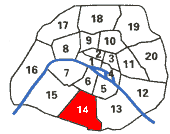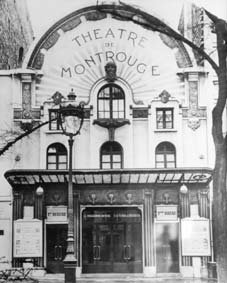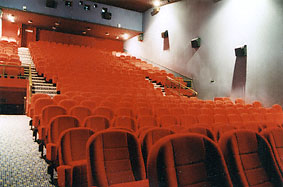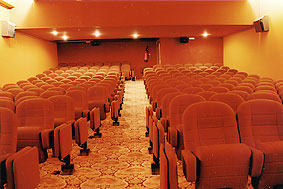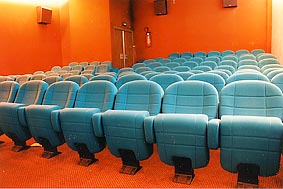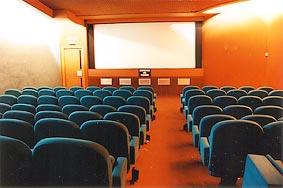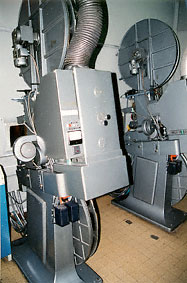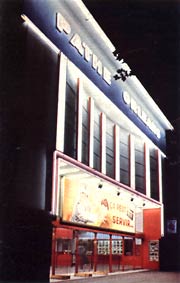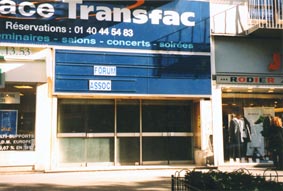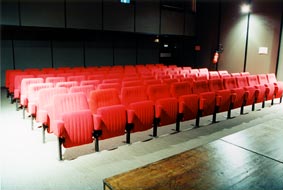Montrouge Palace / Gaumont Sud
 The Montrouge Palace was one of the largest on the left bank; its huge front hid a 1,800-seat auditorium on two levels. At the top of the auditorium, large archs could be seen.
The Montrouge Palace was one of the largest on the left bank; its huge front hid a 1,800-seat auditorium on two levels. At the top of the auditorium, large archs could be seen.
Like the other very large auditoriums, the Montrouge Palace, later named Montrouge Gaumont, was divided into four auditoriums in the early seventies, and was renamed Gaumont Sud.
Unlike others, the new theater had large auditoriums and remained correct. Pieces of the archs could still be seen in the auditoriums. It only played movies dubbed in French.
Theater 1 (which replaced the balcony of the former theater) still had 900 seats and a 40ft screen; it was a kind of less Luxurious mini-Normandie (the Normandie is a prestigious theater located on the Champs-Elysées). It will eventually become the largest auditorium on the left bank by the number of seats.
Theaters 2 and 3 replaced the former orchestra, divided in its length. On the right hand side, theater 2 had 400 seats; on the left hand side, theater 3 had 300. Theater 4 was the only small auditorium in the cinema; it had 120 seats.
But large auditoriums became less and less successful. Gaumont decided to devide again the large auditorium, and to open a state-of-the-art modern multi-screen theater. The Gaumont Sud closed in 1986.
Gaumont Alésia
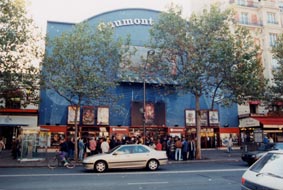
On December 17, 1986, the Gaumont Alésia opened to the public. It had seven auditoriums (this wasn't the exception any longer). The blue front, with painted stars and planets, can't be missed. The neon sign was a mobile movie clap, which wasn't mobile a few weeks later when many viewers complained they could hear its noise during the movie in theater 7.
Moviegoers were pleasantly surprised because some movies were played in their original languages (Ferris Bueller's Day Off in theater 7). Of course I was there for the opening, hoping for a #1 ticket... We went to see the Fugitives, which was played in the largest auditorium. I was the first one to buy a ticket, but I got a ticket from the Gaumont Sud, #400001!
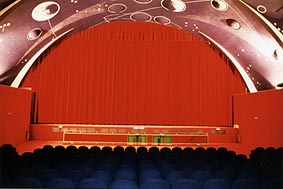
This new cinema's star is theater 1, which is theater 1 from the former Gaumont Sud, minus its rear part. Its false ceiling is missing, which gives the auditorium more height, and allows to see the archs again; the ceiling looks alike the front, all blue with planets and stars, a little like the Grand Rex (but it didn't age very well). The auditorium was also amputated from its sides, now used as corridors leading to the fire exits from the new small auditoriums. The auditorium is rather large, it has 520 seats, and a beautiful screen (15m x 7, or 50ft x 23), where flat pictures have more height than scope; all the screen surface is used for 70mm prints, but the top corners are masked by the arch (it isn't really bothering, but it feels very weird). 70mm haven't been played for years on that screen.
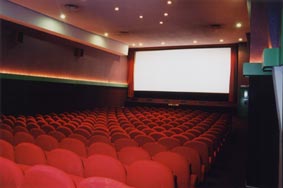
Theaters 2 and 3 had few changes; they can still accomodate 400 and 300, and their screens are 28 and 23ft wide. In theater 2 (left picture), portions of the archs can be seen on the right wall; in theater 3, portions of the archs can be seen on the left wall.
Behind theater 1 and above the lobby, theaters 4, 5 and 6 were made in the volume of former theater 1 of the Gaumont Sud. Theater 4 is nice, with 200 seats and a small screen of 18ft. Theaters 5 and 6 are identical, with 150 seats each and 18ft screens. Their entrance doors are located at the bottom of staircases directly leading inside the auditoriums. Theater 7, which used to be theater 4 in the Gaumont Sud, is small with 100 seats and a 15ft screen.
The sound equipment has improved since the opening. All auditoriums have Dolby SR. Theater 1 also has Dolby SRD and SDDS (no DTS, because the ceiling is too low in the projection booth). Theater 2 has Dolby SRD and DTS.
When I visited the projection booths, I noticed the very long staircase leading to the booth of theater 1 (the former booth of the Montrouge); projectionists need to be in good health! All the booths have double projectors, with the "rock-and-roll" system (half the show on each projector; an endless punched tape is programmed for the first show; like a computer, it will control everything, from the projetors to the lights, the curtain and the cd player; at the end of the reel, the second projector starts, while the first projector rewinds at the speed of 30im/sec; this is the only system allowing to rewind a little bit when something went wrong).
The Gaumont Alésia is located half-way between Gaumont's two Parisians multiplexes, the Gaumont Parnasse and Aquaboulevard, but it still has the largest screen in the arrondissement. Although most of its movies are dubbed in French, it plays some movies in their own languages, and even some art-movies. I think some remodelling should be done soon, like giving stadium-like seating to theater 1; the smaller auditoriums should be demolished and replaced by newer ones.
